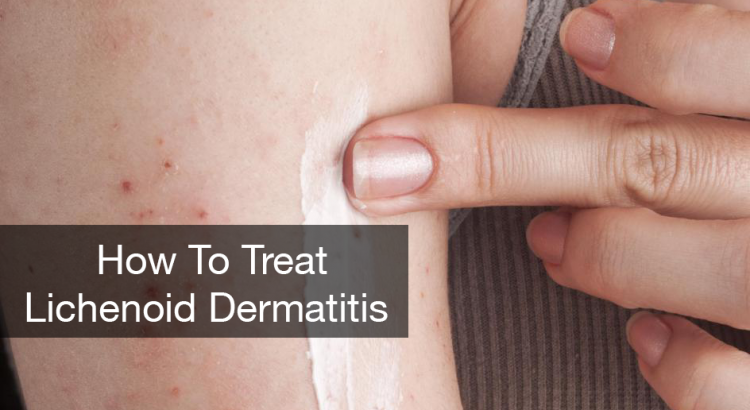What is lichenoid dermatitis?

Lichenoid dermatitis is a skin disorder within the eczema category. It is the least common form of eczema; however, it is still affects many individuals.
The most common people that experience this form of dermatitis are the elderly. But it can occur throughout any time in life and it is recognized by a purple coloring of the skin. This uncommon condition is easily diagnosed because of the purple tint of the polygonal papules, or raised bumps, that form on the skin.
The rash often forms on the ankles, lower back, wrists or forearms. It may appear on the scalp, nails or genitals. These bumps can be anywhere from small, tiny dots to larger discs which can turn into scaly patches of skin that are uncomfortable. The rash may also appear as a line on parts of the body and often a gray discoloration of your skin results once the rash has disappeared.
What are the Causes of Lichenoid dermatitis?
This type of eczema is caused due to the damage to the epidermis of your skin, which alters how the outer layer of your skin interacts with the inner layer. The two layers of your skin develop an allergic reaction to one another, and this reaction causes the area to become inflamed and purple in color.
The exact cause is still unknown; however, dermatologists believe that the condition is caused by an adverse reaction to drugs, chemicals, or due to a viral infection within the body.
The reason it is commonly seen in the elderly is because of heart disease and high blood pressure medications which are the most common causes. It is believed that the condition is caused by an allergic reaction to medication or other chemicals, or that it is developed as a result of a viral infection. Many heart disease, high blood pressure, hypoglycemic and arthritis medications are believed to cause an allergic reaction. Proton pump inhibitors have also been believed to cause it.
Despite the fact that lichenoid dermatitis is not contagious, it can indicate a more serious skin condition, or it could be caused by hepatitis C or graft-versus-host disease of the skin. A person with symptoms of this type of inflammation have to immediately consult a medical professional to determine the cause of the rash and to develop a treatment plan. Commonly, the skin will heal in its own within two years; however, it can suddenly reoccur.
A healthcare professional may prescribe cortisone lotions or foams to treat the rash; however, a patient needs to avoid the chemical substance that caused the irritation. Antihistamines for inflammation or antibiotics for an infection are most commonly prescribed. Depending on the severity of the rash, a medical professional will suggest steroid injections or photo-chemotherapy light treatments. These treatments can only help with the itching or look of the rash, but it will not cure the skin condition.
What are the Symptoms of lichenoid dermatitis?
Lichenoid dermatitis presents itself as purple bumps on your body, which range from a group of tiny dots to bumps that are large in size. These bumps become itchy and swollen, causing an uncomfortable feeling to occur.
Most commonly it appears on the ankles, forearms, wrists, and the lower back, it’s a skin disorder that occur anywhere. It has been found on the scalp, fingernails, tongue, inner mouth cheeks, and genital area.
Without treatment, these bumps become scaly, and they cause the skin to have a gray discoloration after they are cleared from the skin. Because of this discoloration, the skin develops a purple hue. However, with the right treatment, it can clear up, and your skin will remain a healthy color.
How to treat lichenoid dermatitis?
Treatments generally will include:
- Discontinuation of medication if a drug is the culprit.
- Steroid creams such as cortisone creams.
- Antibiotics may also be used to help clear your skin of the rash.
- Laser therapy for cases where skin discoloration has occurred. laser therapy can be used to rid your skin of the purple-gray color and to restore a more natural appearance.
- Antihistamines or steroid shots to get rid of the inflammation and itchy sensation. But these two medicines are only used to relieve the symptoms which means they will not clear up the rash on their own.
In certain cases, lichenoid dermatitis may be the result of more serious health conditions, such as hepatitis C or a disease called grafted-virus-host (GVF). When hepatitis or GVF occur, it’s important to be evaluated by a medical professional even if the condition resolves because the virus can be inside of your body. Even when the virus does not produce any external symptoms, it will come back overtime. So, treatment is necessary.
